Lesson 2: Cause and Presentation
As you may or may not remember from freshman biology, your skin is made up of three main layers: the epidermis, dermis, and the hypodermis and each of these layers can be divided up to their own layers. I’ll spare you all the details, but suffice it to say, there’s a lot going on in your skin. Here today, we are going to focus in on the outermost layer of the skin, the epidermis because that’s where all this KP stuff is going down.
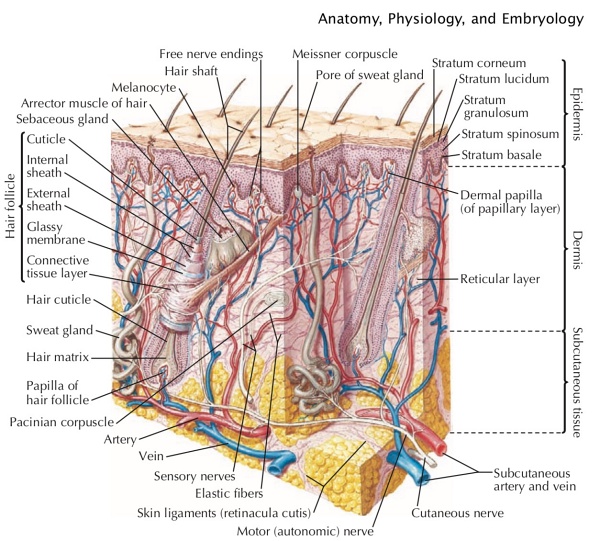
The epidermis is made up primarily of the protein keratin. It is produced by cells called keratinocytes (easy enough) that are found in the bottom-most layer of the epidermis–the stratum basale (highlighted below). These cells produce new keratin all the time that gets pushed toward the surface of the skin. As the keratin gets closer to the surface of the skin it gets smushed and hard. Keratin is what gives our skin the protection we so desperately need from all the germy bugs and harsh elements that are trying to destroy us. It holds all of the individual cells of our epidermis together and it also works to make our hair strong and our nails rigid. Keratin is good. We need it. Until we have too much of it.
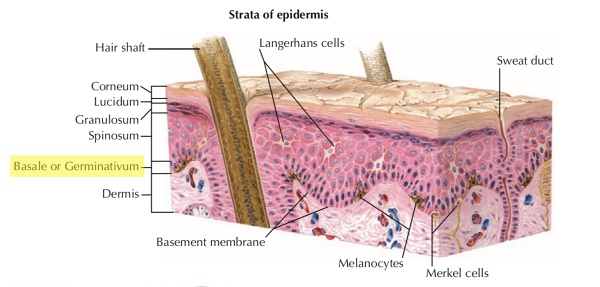
The Problem
In an ideal world, those keratinocytes pump out keratin at a rate that is roughly equal to the rate at which we lose it as part of the normal skin regeneration process, but for some, and by some I mean most (remember that 50-80% prevalence stat?), keratin gets produced faster than we can get rid of it. This backlog of keratin is what causes KP. Hair follicles, a.k.a pores, get filled up with keratin. Sometimes the excess keratin makes a rough patch of skin. Sometimes hairs can get trapped inside the follicle. Sometimes the buildup causes inflammation. No one really knows for sure why exactly this happens and unfortunately there is no cure or quick fix. Don’t lose heart though, it can be treated.
The Manifestation
Keratosis Pilaris can present itself in a lot of different ways and vary greatly in severity. For some, KP looks like rough, skin-colored patches of skin with lots of teeny-tiny bumps (and can even be considered a variant of normal skin). For others, those teeny-tiny bumps are more red and inflamed and therefore more noticeable. And for those who are truly unlucky, the keratin buildup can be so severe that larger, acne-like pimples and red spots form over the affected area–when things are this severe it has its own name Keratosis Pilaris Rubra. Rubra being Latin for red. (Look at that, foreign language lessons too!)
Most people with KP will experience the full spectrum of symptoms. How severe and noticeable KP is can-and most likely will-fluctuate from time to time. Seasonal changes can have a big impact and cause flare ups. In the winter, colder temperatures and lower humidities can dry out the skin. Dry skin and KP do not go well together. Read up on how using a humidifier might be able to help during those chilly nights. Summertime also brings it’s own perils for the KP sufferer. Being out in the sun too much, swimming, and sweating constantly can all make symptoms worse.
KP most often affects the backs of the upper arms, thighs, and face. Location of symptoms in these areas is one of the best ways to determine if what you’re dealing with is actually KP. Some people will notice KP in only one of these areas while others will have bumps in all three. It is also not uncommon to have different areas of the body have different severity or appearance.
Pictures of Keratosis Pilaris
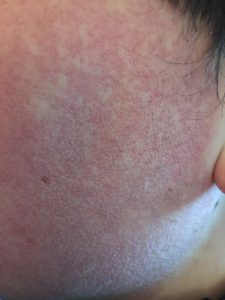
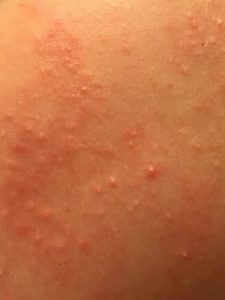
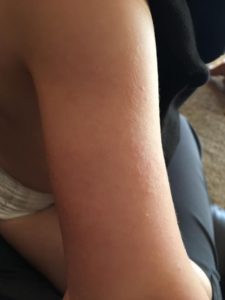
Skin Conditions Similar to Keratosis Pilaris
As with any medical condition, there are some grey areas and sometimes it’s hard to tell exactly what’s going on. Skin conditions can often present very similarly to each other and make a definitive diagnosis difficult. You can read more about the conditions most commonly mistaken for KP here, but in the meantime here is a list of other skin conditions that are similar to Keratosis Pilaris that you can google at your leisure:
- Eczema
- Dermatitis
- Acne Vulgaris
- Eruptive Vellus Hair Cysts
- Folliculitis
- Keratosis Follicularis (Darier Disease)
- Kyrle Disease
- Lichen Nitidus
- Lichen Spinulosus
- Milia
- Atopic Dermatitis
- Perforating Folliculitis
The Recap
Keratosis Pilaris is a headache. Too much keratin gets produced by the skin cells and it builds up leaving rough areas of skin on the arms, legs, and face. KP can be all over the board from person to person and even season to season. KP can’t be cured, but it can be managed. A good treatment routine is key. More on that later, but our next lesson will focus on what NOT to do.
Homework

Think back through your experience so far with KP. Have you noticed any patterns that you can might be related to worsening symptoms? Write these down and stay mindful next time your kid’s skin is a little worse and see if you can come up with any aggravating factors that can be easily eliminated.
Proceed to the next lesson
Back to the Start
Introduction…Cause and Presentation…What Not to Do…Treatment…Recommended Products

